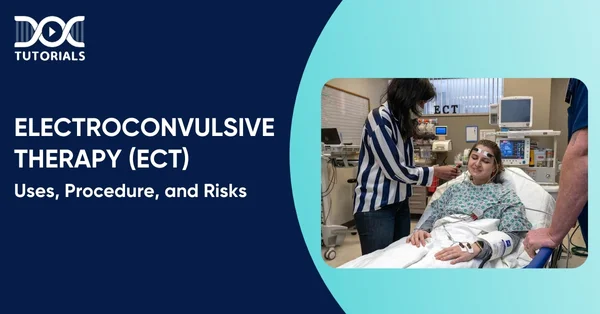Electroconvulsive Therapy | Uses, Procedures, and Risks

Utilising electric current to treat mental health disorders is called ECT or electroconvulsive therapy. The entire procedure is performed under the supervision of professional medical practitioners to ensure that it is carried out safely.
Knowing the uses, methods, and risks of ECT is essential for individuals whose loved ones are getting this therapy. Additionally, it is a crucial topic in the NEET PG syllabus, so aspirants must thoroughly learn this treatment procedure.
Keep reading for a detailed insight into ECT.
What is ECT?
ECT or electroconvulsive therapy is a treatment procedure for certain mental conditions that cannot be treated with medicines or any other treatment method. In this procedure, a small electrical stimulus is applied to your brain that helps trigger a controlled and brief seizure.
Doctors keep the patients under general anaesthesia while giving ECT so that they do not feel anything. This therapy helps treat severe depression, schizophrenia, catatonia, bipolar disorders, etc.
Though experts are not yet sure about the exact working principle of ECT treatment, it helps in the growth of brain cells through new connections. Changes in the brain caused due to depression or any other mental disorders are reversed through this process called neurogenesis.
What are the Uses of ECT?
As already mentioned, when other forms of treatment or medication are ineffective, doctors often recommend ECT. However, if an individual is facing a life-threatening situation due to severe depression, such as being suicidal, ECT comes as the first preference for treatment.
ECT is also used in the following cases:
- Treating older individuals who cope with the side effects of certain medicines
- Individuals who prefer ECT instead of taking injections or oral medicines
- When an individual has had a successful ECT in the past
- In pregnancy, some medicines may affect the growth of the foetus; ECT is used in such cases
What Procedure is Involved in ECT?
The ECT procedure is usually performed in a hospital, often in a specialised unit, and can be done on an outpatient basis. However, for patients who are medically or psychiatrically unstable, the procedure may initially be done.
In contrast, the patient is admitted to the hospital and later switched to outpatient care as their condition improves. The procedure involves the following:
- Preparation
Before the procedure, the patient is prepared by a team of healthcare professionals, including an anaesthesiologist, psychiatrist, and nurse. The patient receives general anaesthesia to ensure they are unconscious and do not experience any pain during the treatment.
A muscle relaxant is also given to minimise physical movement and prevent injury during the induced seizure. An anticholinergic medication may be administered to reduce the risk of abnormal heart rhythms. The patient is pre-oxygenated with a nasal cannula to ensure proper oxygen levels.
- Electrode Placement
Electrodes are placed on the patient’s scalp. The placement can be unilateral (on one side of the head) or bilateral (on both sides), depending on the treatment plan. A bite block is inserted to protect the patient’s teeth and tongue during the seizure.
The patient may be hyperventilated with a bag-valve mask before the electrical stimulus to enhance seizure effectiveness.
- Administration of Electric Current
A controlled, brief electrical current is then passed through the electrodes, inducing a seizure in the brain. The seizure typically lasts between 30 and 60 seconds. The process is carefully monitored using an electroencephalogram (EEG) to track brain activity.
- Monitoring
Throughout the entire procedure, the patient’s heart rate, blood pressure, blood oxygen levels, and muscle activity are carefully monitored to ensure safety. The EEG also helps the team observe the start and end of the seizure.
- Recovery
After the procedure is completed, the patient is moved to a recovery area and monitored as they wake up from anaesthesia. The healthcare team continues to observe the patient until they are stable and alert.
Every step of ECT is conducted with strict safety protocols, ensuring the patient’s well-being throughout the process.
What are the Risks of ECT?
Though ECT is usually safe, here are some of the common risks that one may face:
- Loss of Memory
One may experience retrograde amnesia and face difficulties in remembering things that occurred just before ECT or events that happened months or years ago. Besides, individuals may even forget about the treatment. The memory loss issue may improve after a few weeks or months of the treatment.
- Medical Complications
ECT therapy can lead to other complications, like high blood pressure and an increased heart rate. Some individuals may also experience severe cardiac issues.
- Confusion
Older individuals may often face the risk of confusion after undergoing ECT. However, the confusion may persist for a few hours or minutes after receiving the treatment.
FAQs About Electroconvulsive Therapy (ECT)
- How many types of ECT are there?
ECTs are of 2 types: bilateral and unilateral ECT. In bilateral ECT, electrodes are placed on both sides of the head, stimulating the entire brain, and are often used for severe depression.
However, in unilateral ECT, electrodes are placed on one temple and the top of the head, targeting one side of the brain and usually causing fewer cognitive side effects.
- Is ECT a common treatment?
Although ECT is effective and safe, it’s not commonly used. It’s rarely the first treatment choice; newer medications are available, and only a limited number of hospitals provide this procedure.
- What diagnostic tests are performed before an ECT?
Before starting ECT, your doctor may order blood and urine tests to check organ function, imaging scans such as X-rays or CT (computed tomography) scans of your brain and spine, and an ECG to assess your heart health.
- What are the benefits of ECT?
ECT is highly effective for severe mood disorders, works quickly, and is generally safe, even during pregnancy. It’s valuable when other treatments fail or aren’t possible, and combining ECT with medication often enhances results.
Conclusion
ECT or electroconvulsive therapy is used when an individual is suffering from mental disorders like schizophrenia, bipolar disorders, etc. Individuals undergoing this treatment must learn about its procedure and associated risks to stay protected.
Moreover, NEET PG aspirants must have a deeper understanding of ECT, as it is a vital topic in psychiatry. With DocTutorial’s guidance, study materials, and timely assessments, you can prepare yourself successfully for the medical exam.
Join DocTutorial’s NEET PG course today and excel in your medical career!
Latest Blogs
-

NEET SS Exam 2024: Analysis, Key Dates, Counselling
The NEET SS 2024 exam kicked off on March 29, 2025. Over two days and two slots, candidates across 13…
-

NEET PG Registration 2025: An Essential Guide For Exam Prep
The NEET PG registration, which is conducted online, is a crucial step in the exam process. Filling out the NEET…
-

NEET PG Syllabus 2025: A Must-Have Complete Guide for Exam Success
The NEET PG Syllabus acts as one of the foundation stones for aspiring postgraduate medical students like you who are…




